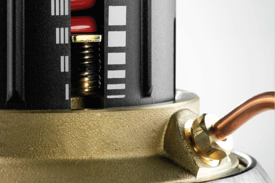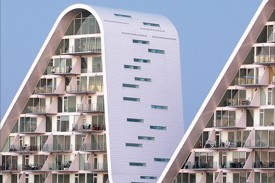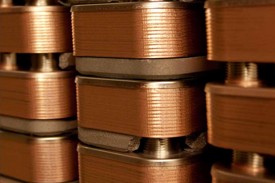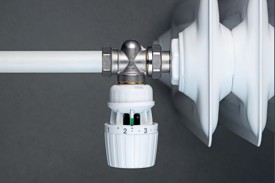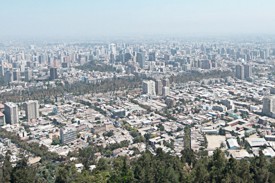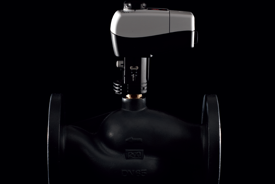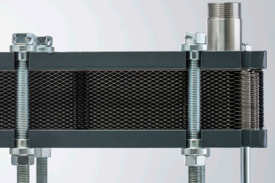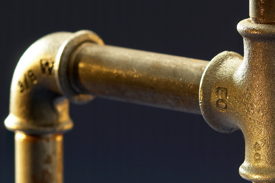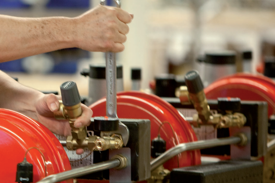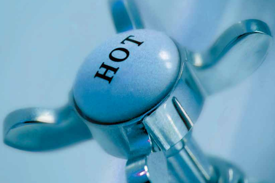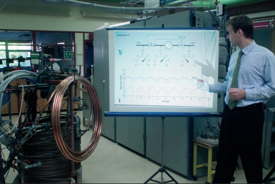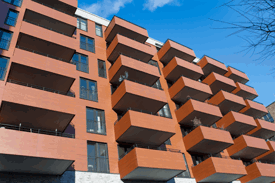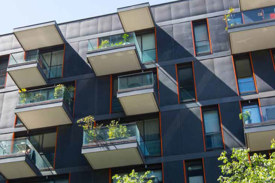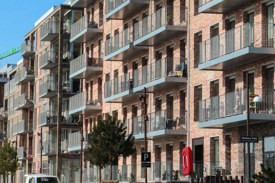-
 Reconfiguring Air Handling Unit control for better performance
Reconfiguring Air Handling Unit control for better performance
PDFThis whitepaper is intended to support HVAC professionals with creating reliable and energy efficient hydronic control solutions for Air Handling Unit (AHU) systems as used in a wide variety of commercial, institutional and multi-purpose buildings. -
 Differential pressure controllers as a tool for optimization of heating systems
Differential pressure controllers as a tool for optimization of heating systems
PDF 3,899 KBIn this article you can read more about differential pressure controllers - how they work and what benefits they bring, the applications where they are used, the advantages for end-users and DH utility companies. -
 Controls providing flexibility for the customer increase comfort and save energy
Controls providing flexibility for the customer increase comfort and save energy
PDF 9,765 KBIncreasing energy prices, together with more demands for comfort lead to further development of DH consumer-end technologies. This development involves better controlling and metering possibilities, so heat supplied to the consumer is not wasted. Blocks of flats include a huge energy-saving potential, as they traditionally make up a big part of the DH consumers in most cities. -
 Impact of lowering dT for heat exchangers used in DH systems
Impact of lowering dT for heat exchangers used in DH systems
PDF 335 KBThis paper describes the impact of using heat exchangers designed for operation at low supply temperature and at small logarithmic mean temperature difference (dT) compared to the level specified and applied today. -
 Low temperature DH consumer unit with micro heat pump for DHW preparation
Low temperature DH consumer unit with micro heat pump for DHW preparation
PDF 7,336 KBIn this paper we present and analyze the feasibility of a district heating (DH) consumer unit with micro heat pump for domestic hot water (DHW) preparation in a low temperature (40°C) DH network. -
 Trend for heating system renovation in multi-family buildings
Trend for heating system renovation in multi-family buildings
PDF 7,942 KBThe activities for building renovation within the rental area in multi - family residential buildings are increasing. This article describes a case story about modernization of a residential building complex initially equipped with a one -pipe system. -
 Pressure oscillation in district heating installations
Pressure oscillation in district heating installations
PDF 7,053 KBDanfoss has been marketing district heating pressure controller for decades, but it is only recently that we have seen an increasing number of inquiries around the question of pressure oscillation in the district heating network. We had carried out an extensive analysis in this area, read more in the article.
-
 Making the case for district cooling
Making the case for district cooling
PDF 313 KBToday, around 10% of the world’s electricity production is used for air conditioning. According to international studies, the demand for cooling of commercial and residential buildings will grow exponentially in the years to come, especially in high-income countries and emerging economies in India, China and South America.
-
 Hydraulic balance in a district cooling system
Hydraulic balance in a district cooling system
PDF 7,365 KBDuring the last two decades, the number of established district cooling systems has increased rapidly. This may be caused by the fact that today's district cooling systems are: • More economically attractive • More environmentally friendly • More efficient
-
 Valve characteristics for motorized valves in district heating substations
Valve characteristics for motorized valves in district heating substations
PDF 3,512 KBThe present paper describes the results from an investigation carried out in connection with the development of a new valve characteristic for motorized control valves for hot water service in district heating (DH) substations. From a theoretical point of view, the paper discusses basic control theories and physical relationships of crucial importance to this application, including the decisively important relationships between heat exchanger, controller, motor (actuator) and control valve. In addition to the theoretical analysis, the investigation is supported by dynamic simulations and results from laboratory experiments. The result of the investigation was the development of a new valve characteristic as described in this paper.
-
 Optimum control of heat exchangers
Optimum control of heat exchangers
PDF 4,811 KBThe present paper concerns the control of high-performance heat exchangers for hot water service. Some of the basic control theories and their decisively important relationships are analyzed from a theoretical point of view. A newly developed control is described, putting the various elements in the design into the perspective of control theory.
-
 Distribution systems in apartment buildings
Distribution systems in apartment buildings
PDF 3,278 KBIn an apartment building, the two main principal heat and domestic hot water (DHW) distribution methods are the riser pipe system and the decentralized system with flat stations. In the first case, the DHW system heat losses may be bigger than the net heat for preparing the DHW.
-
 Dynamic simulation of DH house stations
Dynamic simulation of DH house stations
PDF 3,185 KBDanfoss proceeds on developing simulation models of HVAC components including control equipment that the company produces for central and district heating systems. In this paper some examples are given. The example of a simulated domestic hot water service station is presented.
-
 Cost considerations on storage tank versus heat exchanger for hot water preparation
Cost considerations on storage tank versus heat exchanger for hot water preparation
PDF 515 KBThe aim of this article is to give an economical evaluation of the two typical principles of preparing hot water (HTW), focusing on the system as a whole.
-
 How to avoid pressure oscillations in district heating systems
How to avoid pressure oscillations in district heating systems
PDF 5,074 KBThis paper explains the nature of differential pressure controller in relation to oscillation. Some operative hints for eliminating or reducing pressure oscillations are presented. Thanks to the application knowledge in the field of differential pressure control, it is now possible to solve pressure oscillatory problems in already existing applications, and to offer specific advice regarding the right design of new applications in order to eliminate the risk of pressure oscillations. Read full paper to find out more.
-
 Analysis on flat station concept
Analysis on flat station concept
PDF 716 KBIn some countries the flat station concept is becoming a common way of realizing heating and domestic hot water (DHW) installation in blocks of flats. Anyhow, in other countries it is at the very beginning. Experience from those countries reveal a number of questions when understanding and evaluating the flat station concept. -
 Practical guidelines for creating energy efficient multi-family residential heating systems
Practical guidelines for creating energy efficient multi-family residential heating systems
PDF 7,156 KBThis whitepaper is intended to support heating professionals with creating complaint free and energy efficient two-pipe radiator heating systems in (multi-family residential) buildings. The guidelines are relevant for retrofit, renovation as well as new construction situations.
-
 Auto tuning and motor protection as part of the pre-setting procedure in a heating system
Auto tuning and motor protection as part of the pre-setting procedure in a heating system
PDF 819 KBAutotuning: Adaptive setting of a domestic hot water service controller. Motor protection: Automatic setting of a controller during low performance. A precondition for a well functioning heating system is that the correct settings are made before it is put to use. Adjustments are necessary to preset the regulating parameters. This article deals with the way in which the automatic setting of system control parameters is performed and the advantages this gives. -
 Control concepts for DH compact stations
Control concepts for DH compact stations
PDF 706 KBThis article describes the basic functionality of four control concepts, a thermostatic controller, a proportional controller and a parallel and serial coupling of those. The focus is on plate heat exchanger control, and the investigation is based on dynamic simulations, i.e. on models verified up against practical measurements. -
 Hydraulic balance in a district heating system
Hydraulic balance in a district heating system
PDF 756 KBEstablishing a hydraulic balance in a system often is a matter of controlling the differential pressure to a level necessary for operating the substation and thereby also controlling the flow rate in individual branches. Controlling differential pressure and flow rate in the system can have advantages for customers and utilities. -
 Reducing oscillations in a HVAC system
Reducing oscillations in a HVAC system
PDF 338 KBIn a HVAC system as well as in a process plant, a district heating and district cooling utility, periodical oscillation of the control loop might occur. It has several reasons. Non linearity of the process, excessive amplification of the controller and an oversized system are just few of the reasons.
-
 The role of district cooling in the future energy systems
The role of district cooling in the future energy systems
The role of district heating in future smart energy infrastructure has been fairly well discussed but its counterpart, district cooling has as well a large role to play. District cooling is a centralized solution for providing cost efficient and environment friendly cooling to buildings. When considering district cooling one normally thinks that it is a solution for the warm climates.
-
 The benefits of low temperature district heating and geothermal heating
The benefits of low temperature district heating and geothermal heating
In light of the continuous requirements for increased energy efficiency and utilization of renewable energy sources for the future it is relevant to increase focus on the combination of geothermal heat sources and low-temperature district heating (DH) systems, also referred to as the 4th generation DH.
-
 Reaching energy efficiency goals with district energy networks
Reaching energy efficiency goals with district energy networks
Improving energy efficiency, reducing carbon emissions and cutting energy bills are ever-growing concerns for almost everyone – industry and manufacturing, commercial facilities, government entities and personal homeowners alike. There is a demand for efficient and clean energy technologies that will help achieve these goals.
-
 Building solutions for low temperature heat supply
Building solutions for low temperature heat supply
When utilizing low-temperature district heating it becomes important to achieve good control at the consumer side to meet the required cooling of the supply. The low supply temperature as such is not a big concern for thermostatic radiator controls. When it comes to the domestic hot water the low supply temperature can cause challenges when it comes to Legionella growth.
-
 Distribution of district heating 4th generation
Distribution of district heating 4th generation
District heating (DH) is here to stay. Looking back on the history of DH it goes quite some years back. During the years it has developed to fulfill the demands as they came up, typically driven by the demand for reduced investment and heat costs, but also lower equipment space demands, concerns of energy efficiency, environment, longer life-time, and lower fire risks. The development has been categorized in 4 generations which each indicate major changes in the technology.
-
 Distribution of district heating 2nd Generation
Distribution of district heating 2nd Generation
District heating (DH) is here to stay. Looking back on the history of DH it goes quite some years back. During the years it has developed to fulfill the demands as they came up, typically driven by the demand for reduced investment and heat costs, but also lower equipment space demands, concerns of energy efficiency and lower fire risks.
-
 Distribution of district heating 1st generation
Distribution of district heating 1st generation
District heating (DH) is here to stay. Looking back on the history of DH it goes quite some years back. During the years it has developed to fulfill the demands as they came up, typically driven by the demand for reduced investment and heat costs, but also lower equipment space demands, concerns of energy efficiency and lower fire risks.
-
 Distribution of district heating 3rd generation
Distribution of district heating 3rd generation
District heating (DH) is here to stay. Looking back on the history of DH it goes quite some years back. During the years it has developed to fulfill the demands as they came up, typically driven by the demand for reduced investment and heat costs, but also lower equipment space demands, concerns of energy efficiency, environment, longer life-time, and lower fire risks.
-
 District heating substation with electrical heater
District heating substation with electrical heater
It is a fact there is abundance of low-temperature renewable energy sources that are waiting to be utilized. The limiting factor for taking advantage of those heat sources has historically been the temperature requirements of space heating installations. With the increased number of low-energy buildings and floor heating installations the requirements to the supply temperature has been decreasing, which opens up the possibilities for exploiting the unused low-temperature energy sources.


